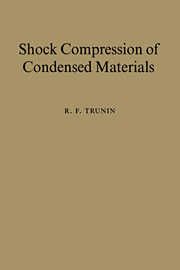Preface
Published online by Cambridge University Press: 03 December 2009
Summary
This book summarizes the results of the fifty-years work of a team of scientists and engineers of the Russian Federal Nuclear Center or All-Russia Research Institute of Experimental Physics (RFNC–VNIIEF) in Sarov (former Arzamas-16), N. Novgorod region. Their effort was concentrated on measuring parameters of compression of condensed materials under intense shock. For the last forty years, the author has participated in this research.
It has been no secret for a long time that the research on shock compression initiated in the USA during World War II and in Russia (then USSR) immediately after the war was directly related to the extremely difficult problem of designing nuclear weapons. No wonder that these investigations remained top secret for a long time, and for ten years after the start of this research only some measurements of shock compression of ‘non-secret’ metals were published (data about radioactive materials have not been published to this day).
The application of new techniques led to a considerable jump in pressure as compared to the parameters of high-pressure static experiments of that time, P = 10 GPa, performed by P. Bridge-man, who was later awarded the Nobel Prize in physics. The first American publications about shock compression at pressures of up to 50 GPa date to 1955, and the first Russian publications at 400 GPa to 1958.
To begin with, the compression parameters of metals, especially those used in structural components of nuclear bombs, were measured. In due time the range of materials studied under shock compression widened rapidly. It included other metals and non-metallic chemical elements, metal alloys, various mixtures of materials. minerals, organic conpmounds, liquids, etc.
- Type
- Chapter
- Information
- Shock Compression of Condensed Materials , pp. ix - xiiPublisher: Cambridge University PressPrint publication year: 1998

